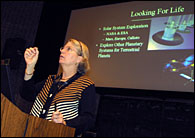Making contact
Anyone who has ever pondered the glittering stars of a clear night sky has asked the question -- are we alone in the universe? For most of us it's nothing more than a passing thought, but for Dr. Jill Tarter, it's her life's work.
 Dr. Jill Tarter
Dr. Jill TarterPHOTO: Owen Egan |
|
The astronomer and astrophysicist is the principal investigator at SETI -- the Search for Extraterrestrial Intelligence based in Mountain View, California.
Hajatollah Vali, who created McGill's unique interdisciplinary class on astrobiology invited Dr. Tarter to explain current efforts in earth's search for company in the galaxy for McGill's astrobiology lecture series.
Although the decades-long effort to find intelligent life in the universe other than on earth has yielded no positive results, Tarter remains unfazed. With billions of galaxies, each containing billions of stars -- some 75 of which have already been shown to have planets orbiting them, she says statistics are in her favour.
So far, the controversial Allan Hills asteroid that some researchers say contains evidence of microscopic life on Mars is our only clue of non-terrestrial biology. Even that isn't conclusive -- and Mars is a lot closer than any of the star systems now being studied by SETI.
Tarter believes that life is not just a probability, it's a "cosmological imperative." The cataclysmic explosion that created the sun also created a lot of debris -- debris that battered the earth in its infancy in the same way as it left craters on the moon. That anything would survive those early impacts and the resultant climactic upheaval indicates that life always finds a way to continue.
"The fact that life did survive here encourages us to think that it could have survived elsewhere in the universe," she said.
Finding that life is the challenge. The 75 planets that have been discovered outside our solar system are all several times the size of Jupiter, and orbiting much closer to their stars than do our solar system's gas giants. To find a small earth-like planet over a distance of light years is a task that is beyond our current technology -- but Tarter does not believe that this will always be the case.
Despite the difficulties in being able to find an earth-like planet, new initiatives to search the skies are on the horizon. In 2007 a new satellite will be launched that will observe 100,000 stars continuously. Radio-telescopes like the 350-dish Allen Telescope Array will be able to search much larger portions of the sky at a time, looking for extraterrestrial radio signals.
If an earth-sized planet is found, Tarter says the next step would be to do a chemical assay of its atmosphere. Should the atmosphere indicate the presence of reactive gases like oxygen or methane, chances are there will be some sort of biological life on the planet surface.
What sort of life would it be?
"By definition, any form of intelligent life we (at SETI) can detect would be more advanced than us," said Tarter. "They would have to be using more powerful technology than what we are using."
Whether earth as a whole is ready to make contact with extra-terrestrial civilization concerns Tarter, but she herself is more than ready.
"What they got wrong in Contact [the movie set at SETI] was that when they made contact they didn't break out the champagne," she said. "We have a bottle in our fridge -- because we plan for success."

